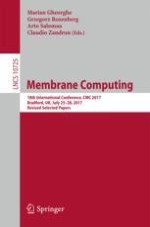2018 | Buch
Membrane Computing
18th International Conference, CMC 2017, Bradford, UK, July 25-28, 2017, Revised Selected Papers
herausgegeben von: Marian Gheorghe, Grzegorz Rozenberg, Arto Salomaa, Dr. Claudio Zandron
Verlag: Springer International Publishing
Buchreihe : Lecture Notes in Computer Science
